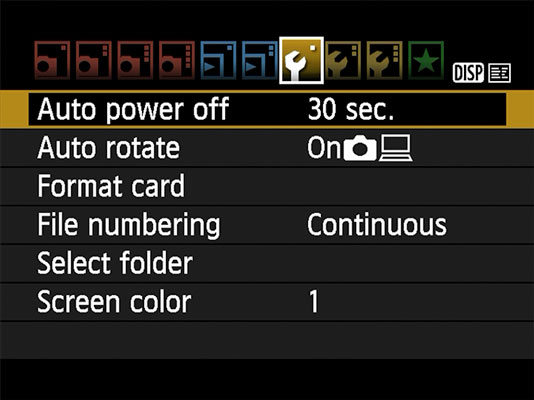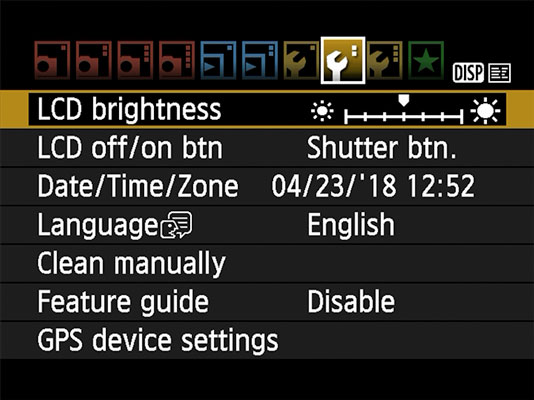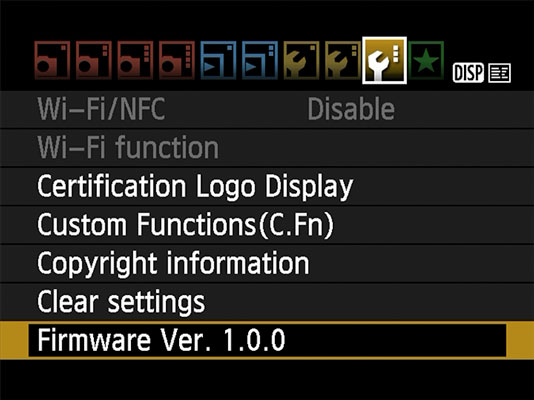The Canon EOS Rebel T7/2000D Setup Menu 1
Open Setup Menu 1 to access the following options:- Auto Power Off: To save battery power, the camera automatically goes to sleep after a certain period of inactivity. By default, the shutdown happens after 30 seconds, but you can change the shutdown delay to 1, 2, 4, 8, or 15 minutes. Or you can disable auto shutdown altogether by selecting the Disable setting, although even at that setting, the monitor still turns itself off if you ignore the camera for 30 minutes. Just give the shutter button a quick half-press and release or press the Menu, DISP, Playback, or Live View button to bring the monitor out of hibernation.
- File Numbering: This option controls how the camera names your picture files:
- Continuous: This is the default; the camera numbers your files sequentially, from 0001 to 9999, and places all images in the same folder (100Canon, by default) unless you specify otherwise using the Select Folder option described in the next bullet point. This numbering sequence is retained even if you change memory cards. When you reach picture 9999, the camera automatically creates a new folder (101Canon, by default) and restarts the file numbering at 0001 — again, the folder issue being dependent on the status of the Select Folder option.
- Auto Reset: If you switch to this option, the camera restarts file numbering at 0001 each time you put in a different memory card or create a new folder. I don't recommend this option because it's easy to wind up with multiple photos that have the same file number if you're not careful about storing them in separate folders.
- Manual Reset: Select this setting if you want the camera to begin a new numbering sequence, starting at 0001, for your next shot. A new folder is automatically created to store your new files. The camera then returns to whichever mode you previously used (Continuous or Auto Reset) to number subsequent pictures.
Beware of one gotcha that applies both to the Continuous and Auto Reset options: If you swap memory cards and the new card already contains images, the camera may pick up numbering from the last image on the new card, which throws a monkey wrench into things. To avoid this problem, format the new card before putting it into the camera, as explained earlier in this list.
- Select Folder: By default, your camera creates an initial file-storage folder named 100Canon and puts as many as 9,999 images in that folder. When you reach image 9999, the camera creates a new folder, named 101Canon, for your next 9,999 images. The camera also creates a new folder if you perform a manual file-numbering reset.
If your memory card contains multiple folders, you must use the Select Folder option to choose the folder where you want to store the next photos you shoot. But selecting the menu option also leads to another neat feature: You can create your own storage folders at any time. You might create separate folders for each person who uses the camera, for example. Here's how to view which folder is active and choose a different one:
- See which folder is currently selected. Choose Select Folder to display a list of all folders, with the current one highlighted and appearing in blue type. The number to the right of the folder name shows you how many pictures are in the folder. You also see a thumbnail view of the first and last pictures in the folder, along with the file numbers of those two photos.
- Choose a different folder. Highlight the folder by using the cross keys and then press the Set button.
- Screen color: Select this option to choose from four color schemes for the Shooting Settings display.
 The Auto Power Off setting determines how long the camera waits to go to sleep after a period of inactivity.
The Auto Power Off setting determines how long the camera waits to go to sleep after a period of inactivity.The Canon EOS Rebel T7/2000D Setup Menu 2
Setup Menu 2 contains these options:- LCD Brightness: This option enables you to make the camera monitor brighter or darker. If you take this step, remember that what you see on the display may not be an accurate rendition of exposure. The default setting is 4, which is the position at the midpoint of the brightness scale.
- LCD Off/On Btn: Through this option, you tell the camera what to do with regard to the Shooting Settings display when you press the shutter button halfway. You get three choices:
- Shutter Btn: The display turns off when you press the shutter button halfway and reappears when you release the button. This setting is the default.
- Shutter/DISP: The display turns off when you press the shutter button halfway and remains off even after you release the button. You then press the DISP button to view the Shooting Settings screen.
- Remains On: The display stays on until you press the DISP button. (This setting is a battery-waster because it keeps the monitor on even when your eye is to the viewfinder.)
- Date/Time/Zone: When you turn on your camera for the very first time, it automatically displays this option and asks you to set the date, time, and time zone. You also can specify whether you want the clock to update automatically to accommodate Daylight Saving Time (accomplish this by selecting the little sun symbol and then choosing On or Off).
Keeping the date/time accurate is important because that information is recorded as part of the image file. In your photo browser, you can then see when you shot an image and, equally handy, search for images by the date they were taken.
When the Time Zone setting is active, the value displayed in the upper-right corner of the screen is the difference between the Time Zone you select and Coordinated Universal Time, or UTC, which is the standard by which the world sets its clocks. For example, New York City is 5 hours behind UTC. This information is provided so that if your time zone isn't in the list of available options, you can select one that shares the same relationship to the UTC.- Language: This option determines the language of any text displayed on the camera monitor.
- Clean Manually: This setting, which appears on the menu only when the Mode dial is set to P, Tv, or Av, locks up the camera mirror to allow you to clean the image sensor manually. I don't recommend that you tackle this maintenance job unless you're either experienced at it or willing to risk turning your camera into a paperweight. Instead, take the camera to a local camera store that provides this service.
How do you know when the sensor needs cleaning? Usually, you see a spot in the same position of every frame you shoot. If you clean your lens and the spot remains, it’s sensor-cleaning time. Until you can get your sensor cleaned, the Dust Delete Data feature may be of some help in diminishing the appearance of sensor dust in your images.
- Feature Guide: When this option is enabled and you choose certain camera settings, notes appear on the monitor to explain the feature. Although the Feature Guide screens are helpful at first, having them appear all the time is a pain after you get familiar with your camera. So, I leave this option set to Disable — and for the sake of expediency in this book, assume that you keep the option turned off as well. (If not, just don’t be concerned when my instructions don’t mention the screens in the course of showing you how to work the camera.)
- GPS Device Settings: If you attach the optional GP-E2 GPS device, this menu option offers settings related to its operation.
 Setup Menu 2 offers more ways to customize basic operations.
Setup Menu 2 offers more ways to customize basic operations.The Canon EOS Rebel T7/2000D Setup Menu 3
To access all the options found on this menu you must set the Mode dial to P, Tv, Av, or M. Otherwise, the menu contains only the first two items, both related to the camera's wireless technology. (These items are dimmed in the figure because they’re not available when you connect the camera to an HDMI video device.) To access all Setup Menu 3 items, set the Mode dial to P, Tv, Av, or M.
To access all Setup Menu 3 items, set the Mode dial to P, Tv, Av, or M.Here's a quick rundown of Setup Menu 3 offerings:
- Wi-Fi/NFC: Use this option to turn the camera's wireless connectivity function on and off. To save battery power, keep the feature off when you're not using it.
- Wi-Fi Function: After you enable the Wi-Fi/NFC option, you can access this option, which enables you to customize various aspects of how the camera connects to your smartphone or tablet via a wireless connection.
- Certification Logo Display: You have my permission to ignore this screen, which simply displays logos that indicate a couple electronics-industry certifications claimed by the camera. You can find additional logos on the bottom of the camera.
- Custom Functions: Choose this option to explore a batch of advanced settings.
- Copyright information: If you want to include your copyright information in the metadata (hidden extra data) of your picture files, start by selecting this menu option.
- Clear Settings: Via this option, you can restore the default shooting settings. After selecting the option, choose Clear All Camera Settings to reset everything but Custom Functions settings. To restore those defaults, choose Clear All Custom Functions instead.
- Firmware Ver: This screen tells you the version number of the camera firmware (internal operating software). At the time of publication, the current firmware version was 1.0.0.
Keeping your camera firmware up to date is important, so visit the Canon website regularly to find out whether your camera sports the latest version. Follow the instructions given on the website to download and install updated firmware if needed.





